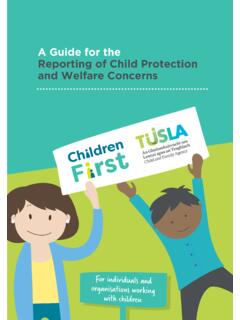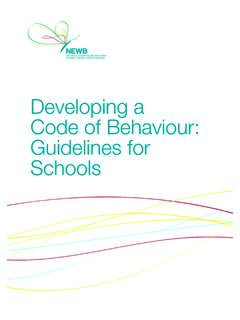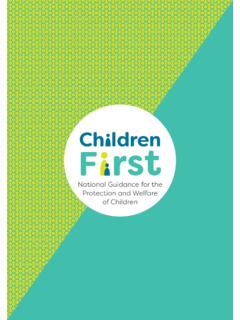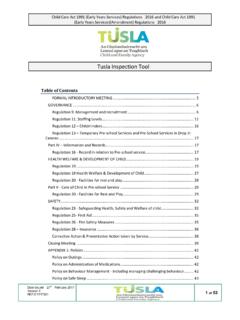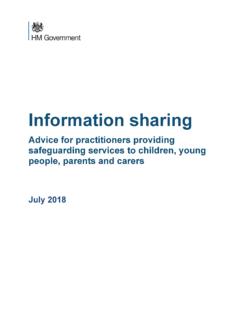Transcription of Child Safeguarding: A Guide for Policy, Procedure and Practice
1 Child safeguarding : A Guide for policy , Procedure and Practice 2nd Edition1 Copyright 2019 Tusla Child and Family Agency. Tusla Child and Family Agency Floors 2-5, Brunel Building Heuston South Quarter Dublin 8 Tel: (01) 771-8500 E-mail: Web: All rights reserved. No part of this document may be reproduced or transmitted in any form or by any means, electronic, mechanical, photocopying, recording, or otherwise, without prior written permission of the Child and Family Agency. 2 Table of Contents Table of Contents .. 2 List of Figures .. 4 Acknowledgements .. 5 Glossary .. 6 Introduction .. 8 Status of this document 8 Who is this document for? 8 children First National Guidance: Key principles 9 Structure of this Guide 10 Learning from previous Child abuse inquiries 11 Working through this Guide 11 GDPR and Data Protection 11 The first task identifying a named person 12 Best Practice Theme 1: Guiding principles.
2 13 Introduction .. 14 Beliefs, values and codes of your organisation .. 14 Commitment to compliance with national legislation and policy .. 15 Who are your guiding principles for? .. 15 Sample declaration of guiding principles .. 16 Review checklist .. 17 Best Practice Theme 2: Key roles in safeguarding .. 18 Introduction .. 19 Named persons .. 19 Designated Liaison Persons .. 19 Mandated persons .. 21 Other roles .. 22 Provider of a relevant service 22 Relevant person 23 Review checklist .. 23 Best Practice Theme 3: Responding to and reporting Child protection or welfare concerns .. 24 Introduction .. 25 Procedures for reporting Child protection or welfare concerns .. 26 Identifying reasonable grounds for concern 26 Categories and indicators of abuse 26 Complicating factors and circumstances which may make children more vulnerable to harm 27 Responding to concerns 28 Reporting concerns 32 Responding to a Child /young person who discloses abuse.
3 36 Responding to adults who disclose childhood abuse .. 38 Responding to allegations of abuse made against workers/volunteers .. 39 Reporting allegations of abuse made against workers/ volunteers to Tusla 39 The Employer s internal personnel procedures for dealing with a worker/volunteer who is the subject of an allegation of abuse 40 Confidentiality .. 41 Information sharing and record-keeping 41 Review checklist .. 42 Best Practice Theme 4: Working safely with children and young people .. 44 Introduction .. 45 Safe recruitment and 47 Procedures for recruiting and selecting workers and volunteers 47 Vetting by the National Vetting Bureau 48 3 Developing a Child safeguarding training strategy .. 49 What should a training strategy include?
4 49 Ensuring safeguarding training is consistent with children First 50 Keeping training records 50 Safe management of activities .. 51 Keeping a register of children and young people 51 Maintaining good record-keeping 52 Health and safety responsibilities 52 Accidents and incidents 52 Safe supervision of children and young people 53 Ensure safe adult- Child ratios 53 Using external facilities whose reporting procedures apply? 54 Online Safety (Including use of photography, video and/or social/digital media) 55 Managing trips away 56 Managing Workers and Volunteers .. 58 Code of Behaviour for workers and volunteers 58 Supervision and Support of Workers and Volunteers 61 Dealing with a concern about another worker/volunteer.
5 62 Disciplinary procedures .. 63 Appeals against disciplinary action 64 Review checklist .. 65 Best Practice Theme 5: Procedures for sharing your guiding principles and Child safeguarding procedures and involving parents, guardians, families, children and young people .. 67 Introduction .. 68 Sharing your guiding principles and safeguarding procedures .. 68 Empowering children and young people to claim their rights .. 68 Anti-bullying policy 70 Guidelines for working in partnership with parents/guardians and children /young people .. 70 Working in partnership with parents/guardians and families 70 Communications strategy 72 Complaints Procedure .. 73 Defining a complaint 73 Who can make a complaint? 74 Publicising the complaints Procedure 74 Processing a complaint 74 Review checklist.
6 75 Best Practice Theme 6: Implementing, monitoring and reviewing your guiding principles and Child safeguarding procedures .. 76 Introduction .. 77 Planning for implementation, monitoring, review and evaluation .. 78 Step 1 Explore/review, plan and resource 78 Step 2 Implement and operate 78 Step 3 Review and evaluate 79 Review checklist .. 80 Appendices .. 81 Appendix 1: Child safeguarding Statements and this document .. 82 Appendix 2 Schedule of relevant services under the children First Act 2015 .. 84 Appendix 3 Review checklist of guiding principles and Child safeguarding procedures .. 86 Appendix 4 Learning from Inquiries .. 90 Best Practice Theme 1 Guiding Principles 90 Best Practice Theme 2 Key Personnel in safeguarding 90 4 Best Practice Theme 3 Responding to and reporting of Child protection or welfare concerns 90 Best Practice Theme 4 Working safely with children and young people 91 Best Practice Theme 5 Procedures for sharing your guiding principles and Child safeguarding procedures and involving parents/guardian, families, children and young people 92 Best Practice Theme 6 Implementing, monitoring and reviewing your guiding principles and Child safeguarding procedures 92 Appendix 5 Child safeguarding : Relevant Legislation.
7 94 Appendix 6 Schedule of mandated persons under the children First Act 2015 95 Appendix 7 Online Safety .. 97 Connections between social media use and negative outcomes 98 Responses & Solutions 100 Information gathered from: 102 Useful websites: 102 Appendix 8 Cyberbullying .. 103 Description 103 Forms of cyberbullying 103 Why does it happen? 104 What are the signs/symptoms that someone is being cyber-bullied? 104 Messages from Research 105 Practice Note 105 Coping strategies for dealing with cyberbullying 106 References for Appendix 8 107 Appendix 9 - Guidance Note on Developing a Child safeguarding Training Strategy, Training Strategy Template, Training Needs Analysis Template .. 108 What is a training strategy? 108 How is a training strategy developed?
8 108 Who may be involved in the development? 109 Child safeguarding Training Strategy Template 110 Training Needs Analysis Template 112 Appendix 10 Organisations Working in Partnership .. 116 Best Practice Themes 1 and 2 116 Best Practice Theme 3 116 Best Practice Theme 4 116 Best Practice Theme 5 117 Best Practice Theme 6 117 Appendix 11 - External organisations using your facilities .. 118 List of Figures Figure 1 Supports in this Guide .. 10 Figure 2 Getting Started .. 12 Figure 3 Internal Reporting Procedure .. 28 Figure 4 External Reporting Procedure .. 29 Figure 5 Reporting Procedure for Mandated Person when Threshold of Harm is Reached .. 31 Figure 6 Implementation Plan Cycle .. 78 5 Acknowledgements Child safeguarding : A Guide for policy , Procedure and Practice (1st edition) was developed by a small working group following extensive consultation with internal and external stakeholders and review of national and international research and Practice examples on best Practice in Child safeguarding .
9 While it is not possible to list all of the organisations which contributed to the development of this Guide , Tusla would like to acknowledge the significant role that their input played in making this a practical and accessible guidance document supporting best Practice in Child safeguarding . The content of Tusla s Child safeguarding : A Guide for policy , Procedure and Practice (2nd edition) is evidence based and evidence informed; reflects a breadth of knowledge and experience; and should support best Practice in Child safeguarding for organisations working with children , young people and their families. Mr Boyd Dodds led the development of the first edition of this document. This second edition reflects updates in children First: National Guidance for the Protection and Welfare of children , Child safeguarding related legislation and Tusla, Child and Family Agency Practice developments.
10 Members of the working group for the 1st and 2nd edition were: x Maureen Crowley Chairperson x Margaret Fitzgerald x Kathryn Morris x Laura Nee x Charney Weitzman 6 Glossary Child safeguarding ensuring safe Practice and appropriate responses by workers and volunteers to concerns about the safety or welfare of children , including online concerns, should these arise. Child safeguarding is about protecting the Child from harm, promoting their welfare and in doing so creating an environment which enables children and young people to grow, develop and achieve their full potential. Guiding principles and Child safeguarding procedures previously referred to as Child protection and welfare policy and procedures, the procedures an organisation has in place to safeguard children from harm and reduce the risks to children of being harmed.




